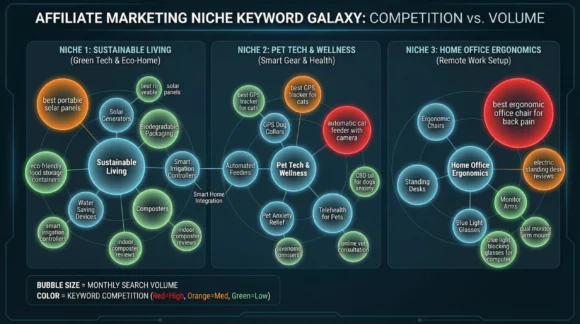Many retirees and those approaching retirement are looking for ways to supplement their income without breaking the bank. Building an affiliate website on a retirement budget is a realistic option that combines low startup costs with the potential for passive income. Even if you aren’t tech-savvy or used to online marketing, you can create a site that works for you if you follow some practical strategies.
Starting an affiliate website during retirement means working with limited resources while aiming to keep costs low. With a bit of research and careful planning, you can build a site that shares products and services you trust and earn commissions from sales without ha
ving to hold inventory or deal with customer service. In this guide, I walk you through a step-by-step process that covers everything from setting your goals to promoting your content on a shoestring budget. By taking a methodical approach, you will be able to gradually develop a website that not only meets your financial needs but also fits your lifestyle in retirement.
Step 1: Define Your Goals and Understand Affiliate Marketing
Before jumping into the technical details, it’s essential to know what you want to achieve. Affiliate marketing means earning commissions by promoting other people’s products on your website. For retirees, this can serve as a way to generate some extra income while enjoying the freedom that retirement offers. Take some time to reflect on your personal goals and how an affiliate site might fit into your overall retirement plans.
Key Questions to Ask Yourself:
- What financial goals am I hoping to achieve with affiliate marketing?
- What type of products or services do I personally believe in?
- How much time can I devote to running and maintaining the website?
- Am I prepared to learn new skills like content writing, search engine optimization, or basic web design?
Example Objectives:
- Supplement retirement income without a significant initial investment.
- Create a blog or review site that shares advice on budgeting, hobbies, or travel for retirees.
- Develop a sustainable online presence that can eventually offer passive income.
- Maintain flexibility in your daily routine by working at your own pace.
By establishing clear and realistic goals, you’ll have a roadmap to bring together your efforts. This planning stage is very important because it sets the expectations for both your website’s design and the affiliate programs you choose to join. Once your objectives are in place, you can tailor every part of your site to meet these targets.
Step 2: Choose a Niche That Aligns With Your Life and Interests
Your niche is the primary focus of your website. For those on a retirement budget, picking a topic you’re passionate about is both fun and sustainable. Not only does this make content creation easier, but the genuine enthusiasm you show can attract readers who share your interests.
How to Choose Your Niche:
- Reflect on Your Interests: Think through hobbies or topics you’ve always loved. Whether it’s gardening, travel, DIY projects, or health and wellness, your deep knowledge can shine through and set your site apart.
- Consider Your Experience: Having first-hand experience in a subject gives you credibility. Your real-life insights can help others navigate similar avenues in retirement.
- Assess Market Demand: Look for topics that have an audience. Use free tools like Google Trends to see what retirees are interested in online and identify gaps where your opinions could stand out.
- Budget Constraints: Some niches require costly setups or specialized content. Choose one that lets you start small while holding potential for growth as you earn income.
Example Niche Ideas:
- A blog reviewing budget travel deals perfect for retirees.
- A site focused on low-cost hobbies that keep retirees busy and engaged.
- A resource hub for retirement-friendly gadgets and tech tools.
- Advice on managing finances during retirement with an emphasis on frugality.
When your niche connects with your personal interests, your enthusiasm naturally shines through in your website’s content. This genuine approach not only builds trust with your audience, but it also makes content creation a more enjoyable and rewarding experience. In time, this affinity for your subject can help your site become a go-to resource within your chosen community.
Step 3: Select the Right Affiliate Programs
Affiliate programs come in a variety of forms, differing in commission rates, product types, and payment terms. It’s essential to find programs that suit your niche and your personal values. As a retiree, your preference might lean towards programs that offer reliability, good support, and straightforward commission structures.
Factors to Consider When Choosing Programs:
- Relevance: Ensure that the products or services fit your niche and offer genuine value to your audience.
- Commission Structure: Look for programs with a decent commission rate and evaluate additional factors such as cookie duration, payment thresholds, and frequency of payouts.
- Ease of Use: It can be beneficial to choose platforms that present user-friendly tools such as dashboards and link trackers, simplifying your monitoring process.
- Budget Considerations: Many successful affiliate programs do not require an upfront investment. Emphasize those where you can start promoting immediately without paying membership fees.
Popular Affiliate Networks:
- Amazon Associates – A beginner-friendly option that covers a wide range of products.
- ShareASale – Offers a diverse selection of merchants catering to different niches.
- ClickBank – Particularly known for digital products and a good choice if your focus leans toward technology or education.
Before confiding in any program, consider signing up for a few trial periods if possible. This trial phase lets you monitor how well the affiliate links perform without any significant financial risk. Prioritizing programs that your audience trusts and have a well-established track record is key to long-term success.
Step 4: Build Your Website on a Tight Budget
You don’t need to break the bank designing your website. Thanks to a number of affordable tools and platforms, you can create a professional-looking site without a large upfront investment. Many retirees especially appreciate tools that let you concentrate on content rather than worrying about technical details. The primary objective is to get a functional, attractive website up as quickly as possible while keeping costs low.
Budget-Friendly Website Building Options:
- WordPress: This platform offers a host of free themes and plugins. Additionally, many hosting providers offer introductory rates that are extremely affordable.
- Website Builders: Platforms like Wix or Weebly provide intuitive drag-and-drop interfaces. Their budget-friendly plans and free trials allow you to experiment without a major commitment.
- Domain Names: Look for affordable domain registration options. In some cases, hosting packages even include a free domain for the first year.
- Open-Source Tools: Take advantage of free plugins and themes to add functionality and style to your site without extra costs.
Step-by-Step Tips for Keeping Costs Low:
- Start with a shared hosting plan, which is significantly less expensive than dedicated servers.
- Use free and low-cost design templates to craft a clean and modern look for your site.
- Plan your site’s layout carefully to limit the need for subsequent changes that could lead to additional expenses.
- Learn basic maintenance skills yourself. There is an abundance of free tutorials available online to help troubleshoot common issues.
By keeping your expenses to a minimum from the very start, you can reinvest any profits back into your affiliate website. This reinvestment can lead to gradual site upgrades, better content, and, ultimately, a wider audience and increased income over time.
Step 5: Create Quality Content Without Spending a Fortune
Content is king in the world of affiliate marketing. The clearer and more insightful your content, the more likely visitors will trust your recommendations and come back for more. What matters most is that your content is straightforward, insightful, and useful—even if it’s produced on a small budget.
Cost-Effective Content Strategies:
- Write Your Own Posts: Use your personal experiences and unique knowledge. Your individual perspective is a huge asset that sets you apart from generic sites.
- Guest Posts: Invite experts with similar interests to contribute. This not only lightens your workload but also brings fresh viewpoints to your audience.
- Free Tools: Use freely available image libraries, SEO plugins, and writing software to polish your posts without incurring extra costs.
- Content Planning: Develop a content calendar to lay out topics well in advance. A well-planned schedule relieves the pressure of last-minute writing and keeps your website consistently updated.
Creating Trustworthy Content:
- Focus on subjects that resonate with retirees and those working with tight budgets.
- Publish in-depth reviews of products, pulling information from credible sources to back up your claims.
- Be open about affiliate relationships so that your readers know you maintain transparency and integrity.
- Share personal stories when relevant; these anecdotes make your content more relatable and engaging.
Remember that quality content doesn’t need to be overly fancy right from the start. Consistent output, even if it’s simple, will help establish your website’s reputation over time. Initially, a modest approach can still lead to substantial growth, and as your site matures, you may decide to upgrade your design or collaborate with professional writers.
Step 6: Market Your Website Using Affordable Channels
Once you have a website filled with quality content, it’s time to attract visitors. Marketing on a tight budget means focusing on organic and low-cost channels rather than expensive ad campaigns. With persistence and creative approaches, you can steadily build a dedicated audience.
Cost-Efficient Marketing Methods:
- Social Media: Use platforms like Facebook, Pinterest, and Twitter. Posting engaging content that includes links back to your articles can drive steady traffic.
- Email Marketing: Build a simple email list using free tools and send regular updates that keep your readers in the loop.
- SEO Strategies: Optimize your posts for search engines by using free plugins and keyword research tools. By focusing on the terms your target audience searches for, you can increase your organic reach.
- Online Communities: Engage in forums and discussion groups related to your niche. Sharing your expertise in these communities can attract visitors who are looking for trustworthy advice.
Promotional Tips:
- Regularly update your social media profiles with links to new content.
- Respond to comments and interact with readers on your website and across social channels.
- If you are comfortable with multimedia, consider incorporating videos or podcasts hosted on free platforms such as YouTube.
- Collaborate with other niche bloggers or websites to extend your reach and build mutually beneficial partnerships.
Marketing doesn’t necessarily require a large financial investment when you have a range of free resources at your fingertips. Dedicating just a few hours each week to engage with your audience and share your content can lead to significant long-term growth.
Step 7: Track, Analyze, and Adapt Your Strategy
After your website is up and running, it’s crucial to track its performance and learn from the data you collect. Tools like Google Analytics and free affiliate dashboards help you get a feel for what’s working and which areas might need a tweak. Monitoring your site’s performance allows you to make data-driven decisions for continuous improvement.
Tracking Your Progress:
- Visitor Data: Track the number of visitors, page views, and the time users spend on your site. This information provides insight into which content resonates best with your audience.
- Affiliate Clicks: Monitor the click-through rates on your affiliate links, which can highlight the products or services that generate the most interest.
- Conversion Rates: Analyze which calls-to-action are most effective. Even small adjustments inspired by these metrics can lead to noticeable improvements over time.
- Budget Analysis: Keep a close watch on your spending to see if there are areas where you can trim extra costs or reinvest more strategically for future growth.
Adjusting Your Approach:
- If certain content topics are not drawing as much traffic, consider refreshing them or focusing on more evergreen subjects that have long-term appeal.
- Experiment with different promotional strategies on social media. A small change in posting time or the format of your content might have a significant impact on engagement.
- Always remain flexible. The online world evolves quickly, and staying sharp by regularly reviewing your strategies will help you keep up with new trends.
Using free analytics tools helps you spot both strengths and opportunities for improvement. With persistence and patient adjustments, even small data-driven tweaks can lead to an ever more optimized website that steadily grows its audience and income.
Step 8: Expand Your Skill Set for Future Growth
As you settle into the rhythm of running your affiliate website, it becomes important to continue growing your own skill set. Learning new skills not only makes managing your website easier but also opens up fresh avenues for increasing your revenues over time. Many online resources are available for free or at low cost that can help you build expertise in areas such as advanced SEO, content marketing, and data analysis.
Consider signing up for online tutorials, free webinars, and community college courses designed for beginners. You might start with simple HTML and CSS basics, and gradually move on to more advanced website management topics. By consistently adding to your skills, you’re effectively investing in the long-term success of your venture. Each new skill can lead to better website performance and provide more ways to attract your target audience.
This phase of growth is very important because it transforms challenges into opportunities. Investing time in self-improvement has a direct impact on the quality of your website and the effectiveness of your marketing strategies. With every new skill you pick up, you set the stage for a more sustainable and rewarding affiliate journey.
Step 9: Engage with Your Community and Build Relationships
Building an engaging community around your website can be one of the best long-term investments you make. A loyal reader base not only provides regular traffic but can also become invaluable advocates for your site. Spend time interacting with visitors through blog comments, social media groups, and online forums relevant to your niche.
Encourage discussions by asking for feedback and offering opportunities for guest contributions. Regularly hosting Q&A sessions, webinars, or even live chats can help you connect more deeply with your audience. When people feel they are part of a community, they are more likely to trust your recommendations and share your content with others.
This approach not only builds trust but also lays the groundwork for long-term success. In nurturing these relationships, you create a vibrant space where ideas are exchanged, and your site continues to evolve in response to your audience’s needs.
Final Thoughts & Next Steps
Building an affiliate website on a retirement budget is entirely possible with the right plan and the mindset to learn as you go. The adventure from setting up your first webpage to attracting meaningful traffic can be both exciting and rewarding. Every step you take, from defining your goals to marketing your content, brings you closer to establishing a reliable secondary income stream that supports your retirement lifestyle.
Your Action Plan:
- Define your goals clearly and research the basics of affiliate marketing.
- Choose a niche that matches your interests and available resources.
- Select affiliate programs that align with your content and audience.
- Set up a basic website using budget-friendly hosting and free design tools.
- Create original, quality content that offers genuine value to your readers.
- Promote your website using organic methods such as social media and email marketing.
- Monitor your site’s performance, adjust strategies based on analytics, and remain flexible as trends evolve.
- Invest in your personal skill set and actively engage with your community.
Every adventure starts with a single step. What small change or new strategy will you implement first? Even a modest beginning can steadily transform into something very important over time. By working methodically and staying consistent, you can build an affiliate website that not only generates income but also enriches your post-retirement lifestyle.
If you have any questions or need further tips, numerous online communities and free resources are available to help you continue learning. Taking the initiative to improve your skills now can lay a solid foundation for ongoing benefits and might even open doors to new opportunities during retirement. Keep pushing forward, and remember that every effort counts toward a more secure and rewarding future.








Building an online business as a retired person is a great idea as there is so much potential and also wisdom that you have gained over your lifetime that you can write about. I think the thing that puts a lot of people off is that they are scared of all this technology and they think that the learning curve will be too large for them to handle.
But if you find a platform like Wealthy Affiliate where the training can be implemented one step at a time it does make the whole process a lot more manageable and a lot less scary.
The best part is that it doesn’t cost an arm and a leg to start a business nowadays.
Absolutely agree! Retirement is actually one of the best times to start an online business — you finally have the life experience, patience, and perspective that many people online are actively looking for. The tech side can definitely feel intimidating at first, but platforms like Wealthy Affiliate make the process so much easier by breaking everything down into simple, manageable steps.
I also love that starting a business no longer requires a huge financial investment. With the right training and support, anyone can learn the skills and build something meaningful at their own pace. It’s never too late to start something new!